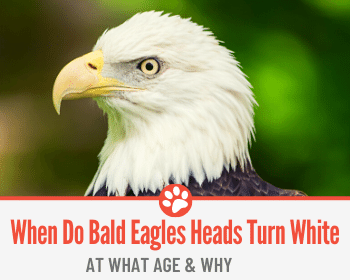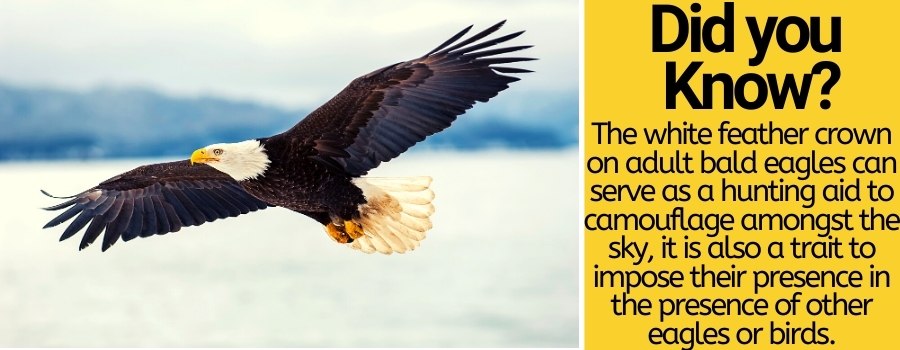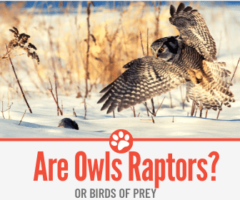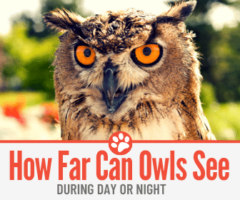 America’s most emblematic bird is sure a beauty to admire and one can be easily intimidated by their powerful brown body roaming around the skies, with a two-meter wingspan, and a white crown on their head, plumage that they actually develop over time.
America’s most emblematic bird is sure a beauty to admire and one can be easily intimidated by their powerful brown body roaming around the skies, with a two-meter wingspan, and a white crown on their head, plumage that they actually develop over time.
In This article we will see when exactly bald eagles get their white heads.
Do Bald Eagles Always Have White Heads?
No. In fact, if you saw a young bald eagle flying right above your head, chances are you would not be able to completely identify the species you just saw. Don’t worry about it; that is because young eagles look nothing like the adult version we all know about. Keep reading to find out more.
When Do Bald Eagles Heads Turn White?
It takes 4 big feather shedding and almost five years for a bald eagle to have a white head. It is often said that eagles win their white crowns as they reach maturity because as soon as they are five years old they will start breeding for the first time, however, some eagles get their white heads a year before that.
The all American bird goes through several plumage transitions that makes the bald eagle almost unrecognizable for the first years of its life. From the moment they are born until they reach full maturity, the bald eagle goes through several molting stages to obtain their whiteheads.
A bald eagle spends most of its juvenile years covered from head to toe in dark feathers, anywhere between brown and black.
As years go by, with each molt the eaglet comes closer to its definitive color, but before it does, a bald eagle goes through four different plumage stages.
We will talk more about each stage later on, but during these years the head stays mostly brown before reaching maturity, while the rest of the feathers go on the reverse, from dark to light and back to brown again.

Why Do Bald Eagles Heads Turn White?
The reason why an American eagle’s head turns white is not fully understood, but experts seem to believe that it has something to do with evolution and conservation.
Just like being brown serves juvenile bald eagles survive and camouflage, the white feather crown on adults can serve as a hunting aid to camouflage amongst the sky, it is also a trait to impose their presence in the presence of other eagles or birds.
As eagles reach their sexual maturity by the time their heads turn white, it is also believed that it is an indicator and attractor to find a mate. As a fun fact, bald eagles mate for life.
What Does Bald Eagle Look Like Before Its Head Turns White?
Young bald eagles can seem to be a completely different species as their color, structure, and their attitude are very different in their first five years. For starters, juvenile bald eagles are mostly dark colored with some visible white feathers along their bellies but not on their heads.
Asides from the notable changes in their plumage, these birds go through some other transformations while they reach adulthood:
Beak: The American bird you know about has a characteristic yellow beak, however, they are born with a black beak which as each year goes by starts tainting brown and then yellow when they reach the third or fourth year.
Eyes: Bald eagles are born with a dark iris that progressively turns into lighter shades of brown and cream in the first years. As soon as the bird turns four, the iris fully turns white.
Flying Shape: There is a slight but noticeable change between a juvenile and an adult when it comes to their aerial shape. A juvenile eagle has wider wings; somewhat rounded wingtips and longer tails, as years go by the wings will turn straighter and narrow.
Bald Eagle Plumage Stages
From birth until they reach full adulthood, bald eagles undergo almost several plumage transformations in color, arrangement, thickness, and patterns to become the all-American majestic bird we identify.
- Juvenile Stage: Before their first year of life, eaglets experience three different sets of plumage in a short period: natal and secondary down, transitional, and finally, juvenile.
- Natal or primary down: Eaglets are born with this light set of feathers and it will be replaced 10 days later by the next coat. Chicks at this stage have white heads and necks, and the rest of the body is covered in fluffy greyish feathers.
- Thermal or secondary down: The first set of feathers has very low insulating qualities, which makes chicks dependent on the warmth of their parents. The secondary down feathers are thicker, darker (Smokey grey) and with efficient thermal properties; and they will last for the next two weeks.
- Transitional: Before the eaglet is a month old, they experience their first pin or blood feathers. This plumage goes from dark brown to complete black; they emerge in canals from the head, wings, and into the back. These feathers will later grow into the chick’s fledgling feathers.
- Juvenile: By their tenth week, eaglets should have fully grown their fledge plumage; both, flight and contour feathers should cover the entire body brown shades with some white pecks here and there. At this stage, eaglets will be almost ready to fledge, and they exercise their wings by jumping on their aeries. This will be their plumage for the rest of the year.
- Basic Stage I & II: For the next two years the bald eagle will almost look like a golden one. The dominant characteristic during these years is that their head will remain fully brown, the chest and wings will have some brown and olive tones and some white molting can be observed especially on the belly.
As the third year approaches, the throat turns somewhat between grey and white and some light smoky feathers appear on the crown and around the mouth. The chest and belly remain mostly white, although sometimes dark feathers appear.
- Basic Stage III: As bald eagles undergo their fourth year, they come closer to what their definitive plumage will look like. The head and neck turn cream white with some brown speckles around; as the area around the eyes remains brown, it will give our friend here a ninja-like look. The tail turns white too and the belly and feathers lose most white feathers and start turning into the chocolate brown we all know.
- Definitive Stage: Finally, as the fourth year ends, bald eagles looks exactly as we know it. Its crown and neck are cotton-white while the rest of their body is brown. As we talked about before, by this stage the bald eagle has also gone through some other changes besides their feathers such as the color of their eyes, feet, and beak, reaching their definitive color by now too.
What Color Are Baby Eagles?
Baby eagles, also known as eaglets, which takes 35 days to hatch. They are born with small black eyes surrounded by a dark gray smudge, and a body covered in a thin layer of light gray feathers and a white layer from neck to head.
During their first weeks of life, eaglets’ feathers are so thin they require their parents’ wings to regulate their bodies’ temperature.
Two weeks later, as soon as they can hold their heads, their plumage will start to darken and thicken enough for them to control their body temperature.
After their first month of life, an eaglet’s feathers will darken even deeper into a blackish-brown tone that will cover from their breast below, including their wings.
When Do Bald Eagles Get Their White Feathers?
Bald eagles have white feathers right after their first weeks of life, however, these white feathers are not always on their head. For the first years of their lives, the white feathers will show on some parts of their body, like the belly and the underneath surface of their wings.
Once they reach adulthood, when they are five years old, the white feathers will be mainly located on their head and throat, and sometimes on their tails.
Typically, the first five years bald eagles will go through a molting season each spring, completing the molt by late autumn.
Related questions.
How Long Do Bald Eagles Stay With Their Parents?
One thing is for sure, eaglets are in no rush and they will not leave the nest until they are ready to fly. Even if eaglets are strong enough by week nine and they will start branching, they will not fledge until week twelve.
Even then, they will come back to the aerie with their parents to be fed and rest.
They will stay with their parents for another couple of weeks or even months until they feel fully independent.
Are Female Bald Eagles Brown?
Yes, even if bald eagles undergo many plumage transformations, it goes the same way for both sexes. Both males and females will have dark heads and lighter brown/white bodies before maturity and white heads and brown bodies as adults.
Do Female Eagles Have White heads?
Yes, both male and female adult eagles have brown plumage, a white head, and yellow feet and eyes. There are slight differences between both sexes, but they can actually be told apart if examined closely.
Females are much bigger than males. Females are a third longer than males, being about 37 inches compared to 34-inch males; they are also 30 percent heavier and their back claw and wings are also slightly more extensive.
An eagle’s pitch also varies according to their sex; females have a deeper tone, while males tend to have a higher pitch.






